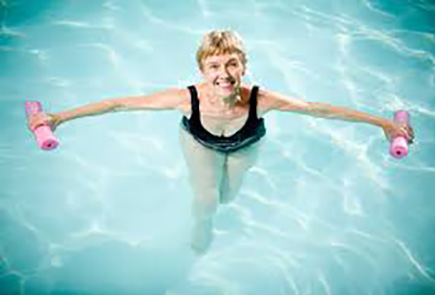 Arthritis affects 40 million people (almost 1 out of 6 adults). Osteoarthritis (OA) is the leading reason for joint replacement surgery in people over age 60. More than a million people every year are getting a total joint replacement; most typically they are an artificial hip or knee. The goals of therapy after a replacement (knee or hip) are pain relief, decrease edema, strengthening; stretching/flexibility, improving range of motion (ROM), progression of ambulation (decreased deviations and increased distance), independence with activities of daily living (ADL), proprioceptive training to improve body awareness and balance, and lastly to return to functional activities. Aquatic therapy has numerous benefits that assist with these goals, and patients don’t even have to know how to swim.
Arthritis affects 40 million people (almost 1 out of 6 adults). Osteoarthritis (OA) is the leading reason for joint replacement surgery in people over age 60. More than a million people every year are getting a total joint replacement; most typically they are an artificial hip or knee. The goals of therapy after a replacement (knee or hip) are pain relief, decrease edema, strengthening; stretching/flexibility, improving range of motion (ROM), progression of ambulation (decreased deviations and increased distance), independence with activities of daily living (ADL), proprioceptive training to improve body awareness and balance, and lastly to return to functional activities. Aquatic therapy has numerous benefits that assist with these goals, and patients don’t even have to know how to swim.
Aquatic therapy benefits are buoyancy/decreased weight bearing, hydrostatic pressure, resistance, and warm water. Buoyancy is probably the largest benefit over land-based therapy because the deeper a body is immerse in water the less shock is transmitted through bones, ligaments, and joints. The buoyant force an object feels depends only on the weight of the volume of fluid the object displaces. An object will experience greater buoyant force in water compared to air because water has more weight. With less demands/forces on the joints, more energy efficient movement can occur allowing improved joint mobility which contributes to dynamic flexibility. With the decreased forces on your body, patients are able to walk, squat, climb steps, strengthen their legs and core, and even jog, with little to no symptoms. Here is a quick guide showing how much decreased force/demand occurs on joints when in water:
- water at waist level = 50% of weight through joints
- water at chest level = 75% of weight through joints
- in deep water = no weight through joints
Buoyancy and hydrostatic pressure work closely together. “Hydrostatic pressure is the pressure exerted by a fluid at equilibrium at a given point within the fluid, due to the force of gravity. Hydrostatic pressure increases in proportion to depth measured from the surface because of the increasing weight of fluid exerting downward force from above.” Due to the force/pressure being put on the body, it greatly enhances venous return and cardiac functions. Buoyancy also assists with venous return by counteracting the downward pull of gravity with the up-thrust of buoyancy. With increased venous return you can exercise more vigorously with less stress on the cardiovascular system and reduce training heart rate. Also due to this same hydrostatic pressure, swelling is reduced in the injured or edematous joints or limbs below the water. With decreased edema, ROM can be worked more easily. Being put under this type of pressure helps you work harder and with fewer symptoms.
All pools have resistance, but not all have warm water. Warm water relaxes muscles and allows for improved flexibility and joint ROM. The perfect therapeutic water temperature range is 88-96 degrees. Resistance will make you stronger because even with simply just walking, you are walking against about 12 times the resistance of air. The resistance of water allows improvement in balance, sensory awareness, and strength in all muscle directions. The turbulence of the water and resistance during movements puts more demands on your balance and promote circulation.
With the assistance from the therapeutic temperature, buoyancy, hydrostatic pressure, and the normal resistance of water, aquatic therapy patients can get a workout without even feeling like they are doing a workout and quickly achieve the goals of therapy.

